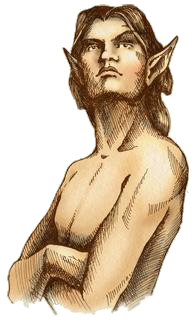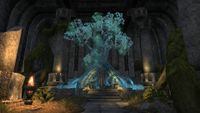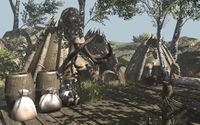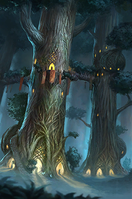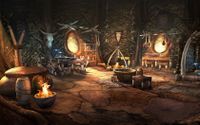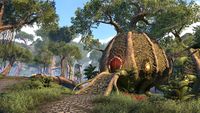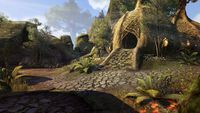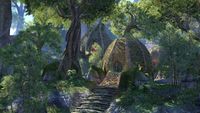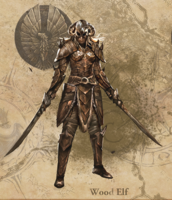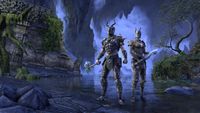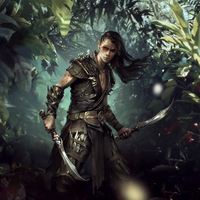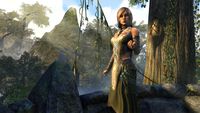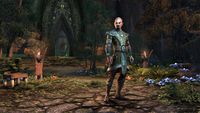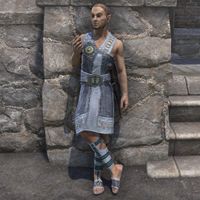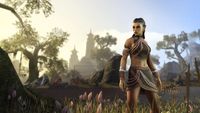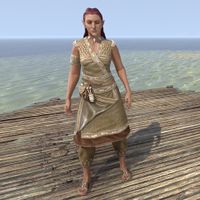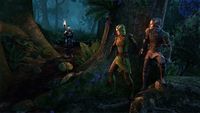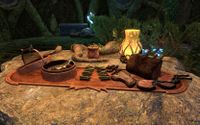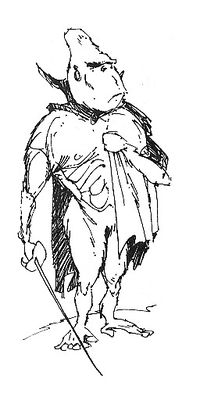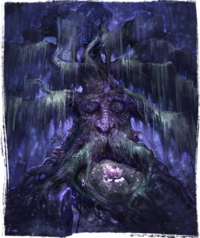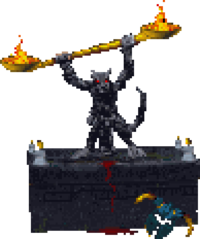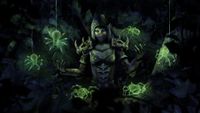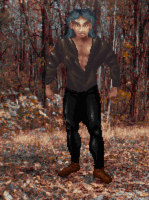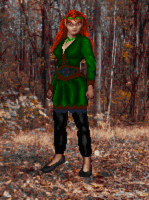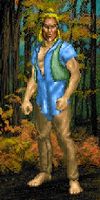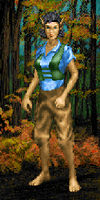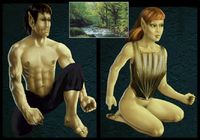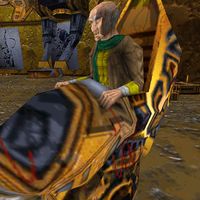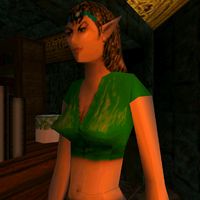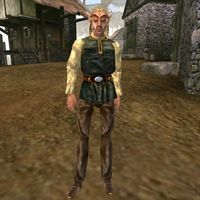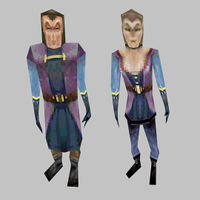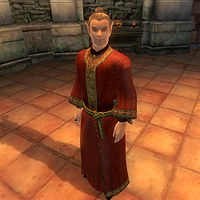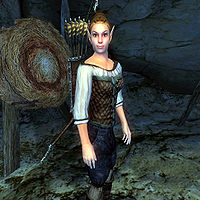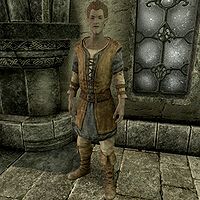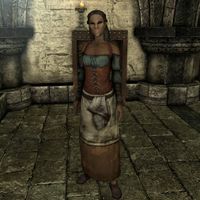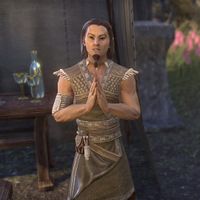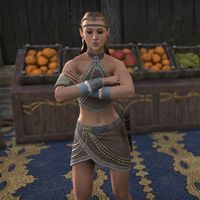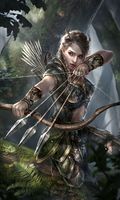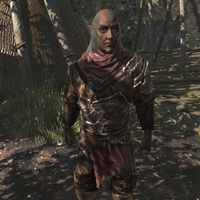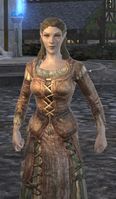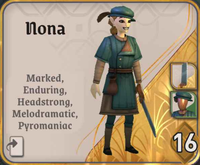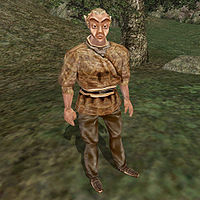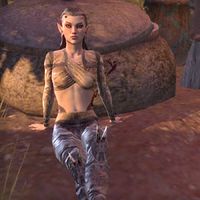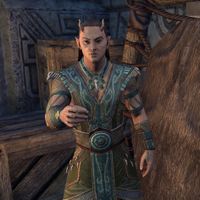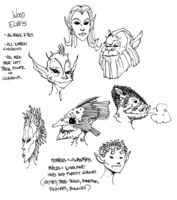Lore:Bosmer
The Bosmer (formerly the Boiche)[1][2] are the Elven clan-folk of Valenwood, a forested province in southwestern Tamriel.[3] In the Empire, they are often referred to as Wood Elves, but they typically call themselves Bosmer[4] and the Tree-Sap people.[5] Bosmer rejected the stiff, formal traditions of Aldmeri high culture, preferring a more romantic, simple existence in harmony with the land and its wild beauty and creatures. They are relatively nimble and quick in body compared to their more "civilized" Altmeri cousins (who often look down upon the Bosmer as unruly and naive). Their agility makes them well-suited as scouts and thieves.[6] However, they are also a quick-witted folk, and many pursue successful careers in scholarly pursuits or trading.[7][8][9] Bosmer live two to three times as long as humans; with a 200-year-old Bosmer being old and a 300-year-old Bosmer being very, very old.[10] Though they are considered less influential than some of their Elven brethren, the Bosmer are also relatively prone to producing offspring with 12 being considered average number of children in the family.[11] As a result, they outnumber all other Mer on Tamriel.[12]
The best archers in all of Tamriel, the Bosmer snatch and release arrows in one continuous motion; they are even rumored to have invented the bow.[13][14][15][16] They have many natural and unique abilities; notably, they can command simple-minded creatures and have a nearly chameleon-like ability to hide in forested areas.[17][18] Many in the forests of Valenwood follow the tenets of the Green Pact. These "Green Pact Bosmer" are religiously carnivorous and cannibalistic, and do not harm the vegetation of Valenwood, though they are not averse to using wooden or plant-derived products created by others.[8][17][19]
Appearance[edit]
As elves of the wilds, the Bosmer people's appearance is said to match the life which grows in Valenwood.[20] They're known by some to be a tall people,[21] despite consistently being known for their small stature.[22][23][24] Sexual dimorphism is present when it comes to height, as Bosmer women can grow taller than men.[25][UOL 1] Wood Elves also have other unique traits, some natural and some artificial. Their eyes have star-like pupils[25] and they're known to file their teeth to sharp points.[26] Some Bosmer have antlers which are typically glued on, although some individuals with real, magically-grown antlers can also be encountered.[27][28][29]
History[edit]
Origin[edit]
- The Boiche Elves were of the Earth Bones who most hearkened to Jephre and his greensongs. They did not build a Tower, they grew it, a great graht-oak whose roots sprang from a Perchance Acorn. And this was their Stone. And because the Acorn might perchance have been elsewhere, thus was Green-Sap manifold and several. And each could walk. — Aurbic Enigma 4: The Elden Tree
The earliest days of the Bosmer are lost in legend. Some speak of the Ooze, the shape-shifting formlessness from which they came before the Green Pact with Y'ffre. The forest was flourishing and primordial still, making shapeshifting a necessity.[30][31] More obscure legends also suggest that not all Bosmer agreed to the Green Pact, and others wished to keep their shape-shifting abilities. According to legend, Y'ffre turned the Ooze into a kind of purgatory state for these individuals, where they would be stricken from Y'ffre's story upon death and unable to interact with any world or afterlife. Eventually, these dissenters were overcome by the other Bosmer faithful to Y'ffre. These "Oathbreakers" were then buried in Ouze so that they could be imprisoned and protected until the time of renewal.[30][32] Others however managed to live on outside the Ouze, and became known as changelings.[33][32]
The Khajiiti Origin story shares similarities, talking about shapeless beings which were given shape by Y'ffer (The Khajiiti spelling of Y'ffre). The Khajiiti origin story tells of Azurah taking some of Nirni's shapeless children and turning them into Khajiit, and Y'ffer learning of this and telling Nirni of what Azurah had done. Seeking retribution for her changed and now lost children, Nirni made the land of the Khajiit inhospitable. To separate her beloved children from those of Azurah, she allowed Y'ffer to change those who remained so that they would always be of the mer, and never beasts, and named them Bosmer.[34]
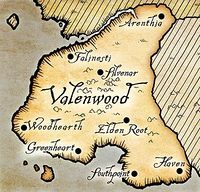
Another tale speaks that Aldmer settlers purportedly arrived in Valenwood long before the First Era. They are remembered as some of the first of the Aldmer to leave Old Ehlnofey.[6] These settlers found the forests of Valenwood, or the Green (though this term can mean more than just Valenwood), so dense and so inhabited by beasts that they could not hope to tame it, so they had to fight and adapt just to become predators instead of prey.[35] Their adaption to life in Valenwood is believed to have led to the creation of the Bosmer.[6][35][36]
It wasn't just Aldmer finding home in Valenwood, as there's some suggestion that early Bosmer were known for intermarrying with humans.[37] Similarly, another legend is that of the Boiche Elves, made from the Earthbones that followed Jephre, grew the first great Graht-oak out of the Perchance Acorn, which would become Tower of Green-Sap. Due to the nature of the Acorn being, perchance, elsewhere, many different Green-Saps sprung in many different forms, forming the walking Graht-Oak forests of the Valenwood. Each one told its own stories of the Green, the forest home of the "Boiche-become-Bosmer".[1] Around the time of the Alessian Slave Rebellion circa 1E 243, the Ayleid sorcerer Anumaril converted the Perchance Acorn of the Elden Root Graht-Oak into a Definite Acorn, which prevented Elden Root from walking and finally gave a Green-Sap a single, definite form. He would further attempt to convert this Green-Sap into a new, singular White-Gold, but due to the Perchance nature of the Bosmeri Tower, he would never succeed.[1]
Anumaril was one of many Ayleid refugees who fled to Valenwood during the "Ayleid Diaspora" which coincided with the end of the slave revolt. However, Ayleids had been migrating to Valenwood even before that. These migrants all agreed to adopt aspects of the Green Pact and to refrain from harming the forest (unlike Anumaril, of course).[38] The establishment of the White-Gold Tower by the Ayleids in the Middle Merethic Era brought increased trade to the Bosmer, and cities like Woodhearth, Haven, and Silvenar flourished.[39][40] The ancient Ayleid site of Hectahame is home to the Heart of Valenwood, a magnificent tree of immense power which stands as the physical symbol of the soul of Valenwood. However, around the time when the Ayleids first came to Valenwood, a necromancer twisted the power of the Heart and used it to raise an undead army, forcing the Ayleids to seal off Hectahame, along with the Heart, in order to contain the horde.[41] Ayleids and Bosmer during these early days had to fend off numerous savage attacks upon Valenwood by the Maormer.[40] Though they found sanctuary in Valenwood, the Ayleids who migrated there seemed to fade from history. For reasons which are still debated by scholars, they apparently had little lasting impact on Bosmeri culture beyond imparting some stonework and masonry techniques.[38]
It is said that the city of Arenthia is named after their first King.[42]
The First Era[edit]
Eventually, the Bosmer would be united under the leadership of King Eplear, whose conquest of the wilderness and founding of the Camoran Dynasty heralded the start of the First Era. They made a formal trade treaty with the Alessian Empire in 1E 340, though it would only last for several decades before breaking down into on-and-off border skirmishes with Colovia for most of the First Era.[35]
The earliest known Wild Hunt occurred in 1E 369, which ended with the death of the Nord High King Borgas.[35][43] This assassination can be viewed as an act of self-defense, though perhaps proactive, as Borgas had been journeying to Cyrodiil to rally support for a joint war against Valenwood. Another Wild Hunt would not occur again until the Third Era,[35] though whether one or more occurred then is not clear. After the Bosmer were devastated by the Thrassian Plague in 1E 2714, they were absorbed by the Second Empire. The Empire, in their usual fashion, divided power in Valenwood among several districts to ensure they would not unite against Imperial rule.[35]
In 1E 2920, the last year of the First Era, on the 19th of Sun's Dawn, Molag Bal destroyed the town of Gilverdale in Grahtwood (eastern Valenwood). This prompted Sotha Sil, the living wizard-mystic god of the Dunmer, to negotiate an agreement with several Daedric Princes to forestall further such acts, though the details of this agreement are still unknown.[44]
The Second Era[edit]
In 2E 406, a salacious scandal rocked Valenwood: the sleepy trading post of Cormount of Grahtwood was likely home to numerous potential heirs of the Camoran Dynasty, as Camoran rulers had evidently been journeying to the secluded town for untold years to engage in extramarital relations. Cormount's population nearly doubled in a week, and weddings became a daily occurrence for months, as many Bosmer sought to sire children with a noble lineage despite the ignoble circumstances. The news even brought many Bosmer who had never lived in Valenwood back to their spiritual home. These migrants, who largely came from Cyrodiil and thus did not follow the Green Pact, were shocking to the established Bosmer of Grahtwood, and tensions brewed for years as a result. Finally, in 2E 420, the migrants' village, New Joy, was burned to the ground for provocations that have been lost to history. The incident eventually inspired the formation of the Blacksap Movement in 2E 489, a Cormount-based cultural organization which hoped to formalize the Bosmeri approach to the Green Pact and thereby prevent any further tragic misunderstandings.[45]
With the fall of the Empire in 2E 430, the regional powers went about warring among themselves, and Maormer pirates were able to get a foothold along the coast which they used to harass the Altmer of Summerset Isle.[35]
During the Alliance War circa 2E 582, the Bosmer became part of the Aldmeri Dominion, along with their allies the Altmer and the Khajiit. The alliance was rocky, though the Thalmor Committee on Alliance Relations encouraged tolerance of the Bosmer's cultural eccentricities to help keep the Dominion together.[46][38] Elden Root was made the capital of the Dominion, and drew many new migrants as a result (this also became the impetus for plans to establish a gladiatorial arena in the city).[47] Many Bosmer saw the Dominion as their only chance at survival.[48] However, many others remained resentful of the alliance, believing the Dominion had "polluted" Valenwood.[49] Resentment may have also festered due to the "Massacre at Cormount", wherein the Grahtwood city was apparently razed by Dominion soldiers utilizing particularly offensive tactics.[50]
In 2E 830, to secure their border from attack, the Altmer, using an old treaty and encroachment from Colovia for justification, invaded Valenwood and reestablished the Aldmeri Dominion.[17][35][51] Details on the circumstances leading up to this are disputed,[17] but they formed the Thalmor and apparently brought peace to Valenwood until the Dominion was absorbed by the Third Empire of Tiber Septim.[35] During the War of Rihad in 2E 862, Colovian armies employ the Bosmer as archers, though they proved to be prone to desertion.[17]
The Third Era[edit]
The Camorans, who had managed to survive as a Bosmeri power, were made rulers again and led the Bosmer through 250 years of peace.[35] In 3E 249, a pretender to the Camoran throne, the Camoran Usurper, led an army of undead and mercenaries which brought devastation throughout Valenwood and most of the western coast of Tamriel until being defeated in 3E 267.[35][52] Since then, the Bosmer have become more isolationist, traditionalist, and distrusting of central authorities, and this political weakness has led to significant losses of territory to their neighbors.[35]
The Bosmer would suffer heavily during the Interregnum, suffering two wars with the Khajiit and a war with the High Elves over several outlying islands that saw large territorial concessions to both powers and no intervention by the Imperial Legions. This stoked several separatist sentiments within the Bosmer people.(?)
Their fortunes would not improve when the Oblivion Crisis ravaged the province of Valenwood as it did all of Tamriel. Soon thereafter the Summerset Isles would declare independence from the Empire under the Thalmor, and not long after the Bosmer would be joined into a union under them, reforming the Aldmeri Dominion.(?)
At the end of the Third Era, rumors surfaced that a prophet called the Precursor had emerged among the Bosmer promising new gifts from Y'ffre to reward their devotion.[35]
Culture[edit]
Art and Architecture[edit]
The Green Pact has had an enormous impact on Bosmeri artwork, crafts and clothing. Their walls are often decorated with skulls and bones.[53] It forces their architects to take great care in their work, apparently strengthening their craftsmanship. Inside tree hollows and residences, hides are stretched out over frames of bones to form partitions.
Traditional timber clanhouses can be found at sites scattered along the coast, where imported lumber is easy to find and cheap to purchase, and through the Valenwood interior, connected only by undeveloped foot trails. [54] More of these types of buildings can be found on the forest floor of cities like Elden Root or Silvenar, typically to house foreigners like the Altmer, but Bosmer cities in the Green are more well-known for the many homes scattered throughout the canopy of the trees.[55]
Many "citified tree-folk" favor a life among the branches, and have woven them together to form limbed pathways without harming the trees. Trails of thick, living vines anchor dozens of platforms that carry goods and people among the graht-oaks. These platforms are hoisted by strong, often foreign laborers. Bone, resin, and sinew are employed by the Bosmer in a plethora of ways, including bridge design. A secondary market in such scraps allows the tree-dwellers to recycle their animal waste by simply tossing it to the ground below, where it is scavenged and reworked into a variety of items.[55] What is not scavenged is absorbed by the roots of the trees and used to keep the settlement healthy. These cities are grown by Bosmer Greenspeakers, who use rituals of speech or song to grow entire villages in just a few days.[56][57] This magic can also be used to fashion wooden items, presumably without violating the Green Pact.[58] Below ground, the trees share a common root system which delivers hot sap into each hut to keep them warm.[56]
Like the Nords, the Bosmer rely heavily on stylized, often interlocking natural motifs in their architecture, crafts, and clothing. However, while the Nords emphasize animals, Bosmeri designs are mainly floral.[59] Since the Bosmer believe that a species' form is a sacred gift from Y'ffre, each species is depicted by a particular, idealized motif which represents the ur-form it was given by Y'ffre. Thus, while there a great plethora of designs in Bosmeri artwork, there is very little room for variation in these designs. Seemingly inconsequential details are rigidly scrutinized, and those which deviate from the norm are looked down upon as plain "wrong".[12]
Clothing and Fashion[edit]
The Bosmer have a sense of fashion that may seem strange to some of Tamriel's other inhabitants. For example, Wood Elves in the Second Era thought that shawls made of blue bunting feathers were the height of fashion, while people from most other cultures perceived them as tacky.[60] Humor also plays a role in Wood Elf fashion, as some clothing items are simply worn as a joke.[61] The Pod-Singers wear clothes made entirely out of animal leather and quills.[62] On the whole, Wood Elves prefer clothing that allows their skin to breathe, and think covering oneself from head-to-toe doesn't make a whole lot of sense. Leather is a common component in Bosmer clothing: doeskin, chamois,[63] crocodile skin—if it has hide, it's free game for leather.[64]
Their gravitation towards leather doesn't keep them away from fabric; wool is also a component in Bosmeri stitchwork.[65] Felt is also used in clothing, with the Silvenar's personal guard being known to wear unique felt caps.[66] Beading, turquoise, sea-beads, and even iridescent deep-forest beetle shells are common accents in Bosmer fashion, giving clothing extra flair.[67][63][68] Translucent cloths, and nothing more, are traditionally worn during ritual dances.[69]
Cultural mixing between Bosmer and Khajiit has had an effect on fashion as well, such as unique hairstyles.[70] A messy and dyed hairstyle popular in the second era was named after the Bosmeri drink, Rotmeth.[71]
Weaponry and Armor[edit]
Due to the proscriptions of the Green Pact, forges are rare in Valenwood, and metal weapons have never been widespread among the Bosmer. They typically utilize bone clubs, or else axes and spears with blades of stone or obsidian. Their composite horn bows are arguably the finest in Tamriel. In coastal towns, imported metal weapons are more common, and Altmeri tutelage in these areas has benefited many Bosmeri swordsmen. However, Altmer who are schooled in "Proper Conflict", as they call their system of swordsmanship, typically refuse to adapt their techniques to the needs of their shorter cousins, and Bosmer students are typically less attentive to the finer philosophical points of the lessons, thus the experience has often proven to be mutually exasperating.[23]
By the age of fourteen, Bosmer youth are typically proficient enough with the bow to accompany hunting parties.[23] Long-distance archers are known as Jaqspurs.[23][72] It is their style of draw, "snatching and releasing in one continuous motion", which has made the Bosmer famous as archers. Their traditional bows are crafted from horn and sinew. Strings are also made of sinew; Khajiiti gut is said to work best, and is thus prized among Valenwood archers. Bosmeri arrows are carved from bone, and fletched with the feathers of various bird species. They believe the source of bone used influences the characteristics of the arrow. Mammoth bone arrows are thought to strike with enough force to knock down a target. Bird bone arrows fly faster and more accurately. Senche-tiger bone arrows deal extra damage. Trials by Imperial observers have been unable to replicate these alleged effects. Upon hearing this, the Bosmer merely cluck their tongues and smile.[23]
Beetle-chitin is often used in armor and weapons, as it provides the same protection of iron at a much lighter weight. Likewise, beetle-hide is incredibly slick, making it difficult for a weapon to find purchase on armor made from it. It also isn't unheard of for these materials to be mixed with iron and steel.[73] Bone and antlers are also used to accent clothing and armor.[74][65]
Darts of Judgment are very rare and expensive Daedric projectiles fashioned by the Bosmer of Valenwood.[75]
Language[edit]
Food[edit]
- Main Article: Bosmer Cuisine
The Bosmer are bound by the terms of the Green Pact to not harm the Valenwood. The Bosmer do not eat anything made from plant life; fruits are only allowed if they have already fallen from the tree, and the seeds must be replanted, lest they face the wrath of the forest. As such, their recipes tend to include animal products.
The Green Pact is interpreted differently depending on the tribe—foodstuffs such as fruits that fell from the trees, dairy products, honey, mushrooms, and insects are eaten with zest by all but the most ultra-zealous of Pact Bosmer. Ritualistic cannibalism is a part of Bosmeri culture and a requirement for the upholding of the Green Pact; they eat their dead and even their enemies as part of upholding the meat mandate. The practice of cannibalism has fallen out of favor in Valenwood during the Second Era, and is only practiced by the most zealous upholders of the Green.
Subcultures[edit]
Dawnway[edit]
The Dawnway is a philosophy and way of life that emerged among the Bosmer of Valenwood during the Interregnum of the Second Era. It stood in contrast to the Green Pact as an alternate way of life for followers of the Green. The Dawnway is primarily associated with the Dawnwood, a jungled region of Cyrodiil which followers of the Dawnway regarded as their historic homeland.
The Dawnway can trace its origins to the tradition of dawnwalking, which had been maintained by Bosmeri families who could trace their lineages back to the Ayleid Diaspora. The philosophy emerged circa 2E 582 when the forgotten Daedric Prince Ithelia escaped from her imprisonment in Apocrypha, resulting in the denizens of Tamriel remembering her existence for the first time since the Merethic Era. A cult dedicated to Ithelia emerged as a result, and began calling themselves the Recollection. Members of the Recollection were primarily Bosmer who placed great importance in their ancestral links to the Ayleid Diaspora; many Bosmer can trace their ancestry back to Ayleid refugees who fled Cyrodiil following the Alessian Slave Rebellion. Over the centuries, the diaspora in Valenwood were required to adopt the Green Pact and were gradually absorbed into the native Bosmer population.
Society[edit]
The elves of Valenwood have always stood ready to defend themselves against aggression, and have done so on many occasions.[81] They often rely on their forest-coupling skills to make use of guerrilla tactics. The title of their most famous poem, the Meh Ayleidion, means "The One Thousand Benefits of Hiding".[17] However, the Bosmer seem to be the most pacifistic of all the modern races on Tamriel, as they have never instigated war with other nations (leading some more militant cultures to criticize them as cowards),[82] though they have been accused of needlessly escalating some conflicts. They have never found a tried and true ally in any other Tamrielic nation. Mistrust has been engendered by the ritual cannibalism they practice, and it's often difficult for them to adjust their lifestyles to the expectations of other races and cultures. Nevertheless, the Bosmer are heavily dependent on good relations and trade with other races, as the Green Pact forces them to import the timber needed to make their homes, arrows, and other wooden instruments.[3][17][78] Their own resources for trade include hides, river pearls, and finger-bone charms made from the Magically-charged hands of their dead wizards. When they are at odds with Colovia or other trading allies, they are said to rely on piracy or banditry to get what they need.[17] They have attempted to accommodate other races in Valenwood throughout history, though many remained wary of outlander encroachments into their home.[83] To this day, they have little more than foot paths connecting their tiny settlements in Valenwood's sparsely populated forests.[3][84] Some Bosmer practice cannibalism upon their enemies.[85]
The Bosmer greatly value diversity. Their respect for life's many facets is inherent in many of their old sayings, like "One mans miracle is another mans accident".[86] Other races are generally welcomed in most of Valenwood, though most foreigners stay in large cities.[17][35][87] Travelers are encouraged to take care when imbibing drinks of fermented milk which are popular among the Bosmer, as non-Bosmer may have adverse reactions to them.[88][89]
At the clan-level, Bosmeri society is matrilineal.[90]
Greenspeakers are mages who dedicate their lives to working in and alongside the Green itself. They use their spells to guide and enhance the growth of trees and plants, and can create furniture and housing for their people in doing so.[91]
Life in Valenwood[edit]
Though the Bosmer first united under the Camoran Dynasty, this form of governance has been called a "loose hegemony".[90] There are in fact many leaders throughout Valenwood who wield varying degrees of authority, such as the treethanes.[92] Their territory has sometimes been referred to as the "Valenwood Nations",[17] perhaps because of the autonomy practiced by various leaders.[90]
The Bosmer have adapted to life in the Green in many ingenious ways. For instance, in the heat and humidity of Valenwood, popular Altmeri ink refuses to dry. It is still prized, though, as it is perfect for writing temporary messages on certain types of porous stone found in the Green. But to write words permanently, the Bosmer uses a type of ink that can dry even if a parchment is submerged in water. Ink which glows faintly in the dark, perfect for writing in the shadows of the forest, is also prevalent. Writing on a leaf or a flat stone is common in Valenwood, and often preferable in a place where quality parchment is rare and even paper is uncommon.[93] Green Pact typically does not allow the use of paper, which makes vellum made of animal hides more common in Valenwood.[94] They've also found means to both deter and eradicate Hoarvor infestations.[95] Though they refrain from smoking plants, many enjoy smoking bugs from bone pipes.[17][12] Finding light without resorting to the danger of fire is an issue on the perpetually shadowy forest floor, but as the moons rise, additional light is provided by luminous lichen, molds, and fungal growths at the base of the oaks. Higher up, nocturnal flowers feed from the graht-oaks, attracting Torchbugs, whose hives light the branch platforms.[55]
The Bosmer share Valenwood with the Imga and so-called "Wood Orcs", along with the many beasts of the forest, including Centaurs.[17][96] They have a long history of welcoming those who seek refuge within Valenwood.[6] They accepted slaves fleeing the Ayleids, and then Ayleids fleeing the slaves, without showing favorites. Around the time of the Alliance War, they also freely welcomed Argonian refugees who had left their homeland in protest over the formation of the Ebonheart Pact.[97] Many foreigners visit Falinesti at some point, the marvelous traveling city of the Bosmer (though at last report, the city had mysteriously rooted itself).[35] Cultural loyalties have tended to divide the Bosmer, such as the rivalry between the Blacksap and the Camorans, and the schism between followers of the Green Pact and "salad-eaters" who have no qualms about breaking the tenets of the Pact.[83]
Laws and Traditions[edit]
The Rite of Theft is a cherished Bosmeri custom, though one which outsiders have trouble appreciating.[98] The Bosmer steal from each other, and upon return of the stolen item, they demand a boon commensurate to the item's worth.[99] In ancient times, the Bosmer Vanirion the Thief was renowned for demanding over two hundred payments after invoking the Rite.[100] In more modern times, the Bosmer of Greenshade are particularly infamous for their thievery.[87] Occasionally, some Bosmer have been known to observe the Rite of Theft even from beyond the grave, such was the case with the Blackroot Clan when their chief's bow was stolen. [101]
Outsiders who understand the Rite of Theft may use it to their own advantage as well. Three Altmer, the so-called "Heroes of the Sanctuary", once used the Rite of Theft to secure a safe port of Summerset ships. They successfully stole from various treethanes while keeping their own treasure secure, earning the right to build their own settlement, known as Seaside Sanctuary, on the shores of Valenwood.[99]
Often when making contracts with the tribes of Valenwood, one will be expected to put up some sort of collateral to ensure equal treatment between unequal partners, such as when a mundane individual is dealing with a powerful mage. In traditional Bosmeri villages, this involves the more powerful party giving the weaker a loved one as a 'pact-hostage'. Should the contracted party complete their task, the pact-hostage will be returned. If they fail to uphold their end of the contract, the pact-hostage will be killed, cooked, and served up to them as Unthrappa, or Atonement. Eating the Unthrappa represents eating one's failure.[80]
Nearly everywhere outside the cities of Valenwood, Bosmeri tribes in the wilds of Valenwood still practice the tradition of the "Mourning War". When a tribe member is slain, they are symbolically replaced via a hostage-taking raid on a neighboring tribe. If the deceased was an especially powerful or prestigious member of the tribe, multiple captives may be taken to replace them. The captive or captives undergo a period of physical torture, supposedly to test their worthiness, and then are joyously welcomed into the clan. Traditionally, the victim was given the deceased tribe member's position, possessions, and family, though this practice may be rarely honored in modern ages.[102] Mourning wars are an ancient tradition; scholarly references to them date back to the First Era,[100] though when they actually started is not known.
The Rite of Propagation is an ancient rite invoked by villages to prevent stagnation against the Green.[103][104]
Bosmer Clans and Tribes[edit]
|
Religion[edit]
—The Green Singing
The Bosmer venerate many other deities, from Aedra to Daedra to other spirits unique to Valenwood.[105] In fact, few Bosmer outside the Empire accept the limitation of Divines to a mere eight or nine. Most Bosmer claim direct descent from Auri-El, though Y'ffre the Storyteller is their most important deity. They venerate Y'ffre as the spirit of "the now".[106] and like the Argonians, the Bosmer seem to prefer to live in the present, or the "Aurbic Now", showing relatively little regard for the ways of the past (besides when it comes to telling old tales or following the Green Pact, that is).[107]
The Eight[edit]
Y'ffre
Y'ffre is the God of Song and Forest and is the chief god of the Bosmer people. They believe that Y'ffre's first tale was that of the world, giving shape to the primordial Ooze. Only after did the second tale come, that of the Bosmer people, and with it the Green Pact.[31][106] Ehlnofey, or "Earthbones," were created from Y'ffre's corporeal form to establish safety and the laws of nature. These laws took the shape of stories, and there is great debate between tribes competing to interpret Y'ffre's ways and knowledge of the times of chaos, before Y'ffre arrived on the mortal plane. This way, they became a vital part of Bosmeri religion to such an extent that the Spinners, priests of Y'ffre, are considered to hold real power in Valenwood, above treethanes and kings.[105] The Wood Elves regularly leave a variety of offerings at Y'ffre's temples, from beverages to gems to living animals.[108] Treethanes typically wear sashes adorned with thunderbug splints on Y'ffre's Naming Day.[109] Many religious decorations, symbols and fetishes are made in Y'ffre's name.[110][111][112][113][114]
Auri-El
Auri-El is a little worshipped god by the Bosmer. While the Wood Elves do claim descent from Auri-El, they have little affection for the god. At most, offerings and prayers are done at the start of the year, to make up for neglected charity work during months prior.[105]
Arkay
Arkay is the god of burials, funeral rites and is associated with the seasons. The Bosmer invoke him when solving offenses against the Green Pact.[105][106]
Xarxes
Xarxes is the god of secret knowledge and is worshipped by Bosmeri mages who wish to learn unnatural arcane arts. He is said to influence each Bosmer's very being.[105][106]Southpoint annually hosts the "Rites of Xarxes' Memory" at its cathedral.[115]
Mara
Mara is the goddess of love and fertility, just as in many other cultures. To the Bosmer, she is the wife of Auri-El.[105][106]
Stendarr
Stendarr is the god of compassion and rightouesness, though to Bosmer he is known also as the Apologist of Man.[105][106]
Z'en
Z'en, seemingly a god of agriculture thought to have been introduced to Valenwood by the Kothringi, is to the Bosmer the god of vengeance and payment in kind. They appear to be a being of a high cosmic order, and is often invoked by Treethanes in the name of justice, or to end unnecessary vendetas.[105][106] They were once worshipped throughout all of Valenwood, but many of his faithful were wiped out by the Knahaten Flu.[116] Z'en is known as a god of the Green[117] and is invoked by the Stags of Z'en, a group of militant Bosmer, when fighting for the Green.[73] One folk-legend speaks of the Ghost of the Green, a mythical Bosmeri hero who executes the enemies of the Green.[118]
Baan Dar
Baan Daar is a trickster deity, introduced to Valenwood from cultural exchange with the Khajiit. He's linked with good-will, cleverness, and is a god of archery which leads to many Bosmer seeking out his guidance.[105][106] Bosmer and Khajiit alike annualy met up in the ruins of Thormar to partake in drinking and prank wars in the god's name.[119] This event is known as The Boast, and it is said that the best pranksters get to party all they want in Baan Daar's realm.[120]
Other Gods[edit]
The Wilderking
The Wilderking, or Wilderqueen,[121] is worshiped by tribal Bosmer throughout Greenshade. They're said to be like the earth and trees, not understanding hardship and pain, but being fair and kind nonetheless.[122] They're thought to be limitless with untold control over nature and one with the land itself.[123][124][125]
Hircine
Hircine, Daedric Prince of the Hunt has worshipers throughout Valenwood. Invoking the Prince can be seen as harmless and amiable, such as a prayer during a hunt or good-luck charms,[126] though going much further than this is frowned upon.[127] Hircine is a source for tapping into the forbidden shapeshifting nature of the Bosmer people.[128]
Herma-Mora
Herma-Mora is to the Bosmer a trickster spirit known as the Woodland Man. Some Wood Elves insist on "their" Mora being different to the Daedric Prince of Knowledge, [106] but others freely admit that they're one and the same.[129] One active cult was the Wooded Eye in the Drowned Coast.[130]
Jone and Jode
Jone and Jode are the gods of the Moons and spirits of fortune, both of the good and the bad.[106]
Lorkhan
Like most elves, the Bosmer do not forget Lorkhan, the Creator-Trickster-Tester deity and enemy of all Aldmer.[106]
Ius
Ius the Extremely Agitated, God of Animals is represented by statues throughout Valenwood and has strange stories regarding his origins. He's often portrayed holding a large set of scales, but his worshippers have no idea, nor care to know why.[131]
Selene
Selene is a powerful Changeling and a High Priestess of Shagrath, another goddess associated with the Green.[132] She's supposedly a remnant of the Dawn Era and thought to be one of the earliest beings on Nirn. [133] She rules over the Selene's Web region of Valenwood, and is known by her followers as the Forest Mother[134]
Brackenleaf
Brackenleaf is fabled to be one of the first trees of Valenwood, planted by Y'ffre during her world-shaping tale. Legends say the tree's heart holds the same power of creation used by Y'ffre.[135] A settlement of the same name sprouted around the tree and so did a group of warriors dedicated to protecting Brackenleaf, the forest and the way of the hunt.[135][136]
The Eldest
The Eldest is an ancient Strangler which has been in Valenwood since creation itself. It was the lifeblood, the very essence of Greenshade and the state of its being reflected upon the forest around it.[137]
Additional Figures[edit]
Some other gods and figures while not actively venerated or worshipped do have their place in Bosmer traditions and culture. Mistria and Caliron are two figures who the Bosmer exclaim by, and the latter of the two has an ailment named after them. The wife of Xarxes, Oghma is mentioned in the same manner as by the Altmer, created by the god from his favorite moments in history. Anuiel's creation of time-law is said to have been interpreted by Y'ffre to manifest day, night and everything inbetween.[138] They also believe that the stars are holes to Aetherius created by Magnus and other spirits during their escape from Nirn.[138]
The Heart of Valenwood is viewed by Bosmer with both fear and admiration, concerning themselves with atrocities of the past but also venerating its incredible life-creating power.[41]
The Green Pact[edit]
The Green Pact, also known as the Treaty of Frond and Leaf, is a strict code upheld by many of the Bosmer of Valenwood to preserve the Green. It is said to have guided their existence since the beginning of the "great story". Its rules are clear. Do not harm the forests of Valenwood. Do not eat anything made from plant life. Eat only meat. When enemies are conquered, their meat must be eaten, not left to rot. Do not kill wastefully. Do not take on the shape of beasts.
Green Pact Bosmer are said to attack any who would harm the forest in which they live, which they call the Green. However, they usually don't mind other races cutting trees down (most notably in the case of Vinedusk Rangers and Wood Orcs in their respective territories), and are known to buy wood from them. The cannibalistic "Meat Mandate" of the Pact sets them apart religiously from other cultures. The requirement to eat fallen enemies before three days pass is perhaps the most shocking part of the Pact to outsiders. Though many Bosmer still try to respect the Green Pact, the practice of eating dead enemies diminished by the Second Era, and is typically only practiced in the most remote villages. The family members of the warrior who slaughtered the enemy may help him with his meal. Bosmer who honor this facet of the Green Pact typically attempt to prepare themselves before large battles by fasting.
Despite its perceived simplicity the Green Pact's doctrinal details can be baffling to outsiders, its certain aspects are often matters of dispute among the Bosmer. According to the Green Lady, the tenet "eat no plants" would be better rephrased as "harm no living plants". Picking up and consuming fallen fruits is not considered breach of the Green Pact. Dairy products, honey, mushrooms, and insects are generally accepted meals in the Valenwood, and eating them is not considered breach of the Green Pact by all but the most ultra-zealous of Pact Bosmer. Plants that are grown outside of Valenwood, but from seeds native to Valenwood are considered sacred and cannot be harmed.
In return for protecting Valenwood from harm, Y'ffre allowed the Bosmer to make Valenwood their home and granted them his patronage and protection. As a result, they use bone, animal, and insect products widely; imported wood is used when necessary. Rather than drinking conventional liquor made from grain or fruit, the Bosmer consume jagga (fermented pig's milk) and rotmeth. Rotmeth is made from fermented meat seasoned with thunderbug organs, takes years to brew, and is considered a precious ritual beverage that symbolizes "the muscle of the boar, the power of the forest, the strength of the Bosmer people". No wedding can take place without it. Y'ffre is believed to have first blessed them with their form, thus their appearance is sacred, so although Bosmer may take the shape of beasts, the Pact normally bans this practice. However, the Wild Hunt is considered a result of the Green Pact: in return for their patronage to Y'ffre, the Bosmer may perform a ritual in dire times that transforms the participants into a horde of wild, shape-shifting beasts, which go on to lay waste to the enemies of the Bosmer.
The Green Pact made the felling of Valenwood trees by anyone a crime against the Bosmeri religion, though this does not apply to non-Bosmer. There are almost no cities or towns built by the Bosmer themselves. Rather, the Bosmer's relationship with the Pact grants them magical forest-shaping abilities to grow their settlements. The exact process is unclear, but reports claim that it's often a highly ritualized affair which consists of slow, rhythmic chanting for several days. Much like the Meat Mandate, fasting is possibly involved prior to and during the process. Bosmer also believe Y'ffre has blessed them with the limited ability to ask the Green to shape itself to their needs to help them live within the restrictions of the Pact. Some Bosmer during the Second Era refused to follow the Green Pact, as they considered it hypocritical for it to not apply to non-Bosmer and because the Pact was made long before they themselves were born. Despite the fact that Green-Pact did not apply to foreigners, some Bosmer still considered foreigners harming plants as blasphemous crime against the nature. Ayleid Diaspora was allowed to settle in Valenwood on the condition of adopting the Green Pact. Having little choice, the Ayleids agreed to adopt aspects of the Green Pact and refrained from harming the forest, which probably contributed to the dilution of their culture.
The tenets of the Pact have led to many tensions with allies and others who have disrespected their beliefs. More than once, the Bosmer have gone to war to protect the Green. While many "civilized" Bosmer don't adhere as closely to the Green Pact as their tribal brethren, they nevertheless often seem to be staunch advocates for respecting its tenets. Green Pact Bosmer are fanatical in their devotion to the Pact. They have been known to let loved ones die of illness even as the alchemical ingredients which could save them grow nearby. Nevertheless, these forest-dwellers are not savages: they have been described as a highly intelligent, curious, and rational people with rich cultural traditions vested in the forest and in their spiritual leaders, the Spinners of Y'ffre. The Spinners are charged with enforcing the Green Pact, and are said to hold the real power in Valenwood. Accounts suggest they have great influence on the people, and that their sermons touch upon more than just spiritual matters. Every springtime, Green Pact Bosmer gather at the Den of the Eldest for a festival in which they drink, tell stories, and pay homage to the Eldest, an ancient strangler.
Placating the Green is a vital part of life in Valenwood, as the forests will often turn against the residents when the Pact is broken or the Valenwood is otherwise harmed. In order to attone and stop the Green's assault, the clan responsible for that area of land must hold a trial and the party found guilty of violating the Green Pact must be sacrificed to the Green itself, regardless of how limited their involvement was or even whether they were a Bosmer. Three kinds of proof are required for judgment: witness testimony, physical evidence, and a magical omen.
The Green Pact Bosmer are known as fierce warriors, but are also known for the hospitality they exhibit to outsiders who respect their ways. Their stories speak of the Ooze, a purgatorial state reserved for Bosmer who violate the Pact (who are called Apostates), as well as the harsh punishments the Green unleashes on those who would harm it.
The Ooze[edit]
The Ooze is a Bosmeri term that refers to the formless chaos that existed prior to Y'ffre's Naming. According to legend, Y'ffre would shape the Ooze into all of creation by telling their stories. Even after creating the Green, the Bosmer, and the rest of life, though, some formless nothing still remained. Y'ffre decided to speak one final story to give the Ooze purpose, saying that any being who violated their Green Pact with the Valenwood would be cast into the Ooze and stricken from the story of Tamriel.
Most Bosmer recognize the Ooze to be a sort of 'spiritual prison' for Oathbreakers who disobeyed some aspect of the Green Pact. These individuals would be shunned by Y'ffre, who represents the living moment, and their spirits would be tied to their remains for eternity. These Oathbreakers could only play witness to all the transpires on Nirn and beyond, and were unable to participate or interact with Nirn in any meaningful way, stuck in a purgatorial state for all time. The rules that dictate whether someone will be trapped in the Ooze upon death are harsh, but clear. The moment someone breaks the Green Pact or otherwise displeases Y'ffre, no matter how inconsequential or accidental their crime, their soul will be bound for the Ooze. This fate can even be extended to outside intruders in the Valenwood under certain circumstances. Those trapped in the Ooze, however, are not without help. Spinners have been known to communicate with the remains of those who rest in the Ooze and even free them if they so choose. Additionally, Bosmer in the Ooze are still bound to Bosmeri customs, and invoking one such as the Rite of Theft can grant complete control over the Oathbreakers, allowing even for someone to command them to be freed from the Ooze.
The Silvenar and Green Lady[edit]
The Silvenar is the Voice of the People for the Bosmer. While often viewed by outsiders as a title for the Bosmer's political representative for foreign affairs, the Silvenar is more than a mere politician. Each person who bears the title is thought of as merely the Silvenar's aspect. The Silvenar represents the Bosmer people legally, physically, and emotionally. He is said to be their spirituality, in contrast to the Green Lady, who is their physicality. It is said to be the union of the two that makes Valenwood whole. He reflects the state of the Bosmer people in his way of thinking, his health, and even his gender. He is inseparably tied to the Bosmeri people, and they to him, making him supernaturally empathic and aware of their concerns. They also believe that he looks after their spirits, as well as their bodies. As the Voice of the People, the Silvenar has many rights which grant him great authority in Valenwood. For one, only the Silvenar can grant foreign building and trade contracts, meaning any foreign power which wishes to build in Valenwood or do business with the Bosmer must deal with the Silvenar first.
How the Silvenar and, by extension, Green Lady, came to be is shrouded in mystery. Some folktales claim that the first Silvenar and Green Lady were pilgrims, a childless couple who tended to the Eldest like their own offspring. The Green Lady, however, insists that her memories date all the way back to the Dawn Era.
As the Silvenar exists primarily as a story, his only true origin is the tale of his meeting with the Green Lady. In the tale, the Silvenar begins as a being who can see the whole of Valenwood and is left saddened and empty by its purely primal nature. He eventually comes across a Bosmer unlike any he had seen before, whose raw strength and passion made all before him terrified. She begins to attack him, but he instead tells her to stay with him and see the beauty of the forest. Eventually, The Green Lady comes to see the Valenwood as the Silvenar does, while the Silvenar's emptiness became filled with her passion. The two became bound to one another, both taming the wilds and strengthening the Green in the process..
This story, in addition to functioning as the beginning of the Silvenar, also serves as the Silvenar's now and future. Each time a Silvenar dies, a new one is selected by the Green and will once again repeat this tale to unite with their Green Lady. As such, the Silvenar is a constant in Bosmeri society.
While the Silvenar represents the civilized nature of the current Bosmer, the Green Lady has the raw physicality and passion of their primal past. If the Silvenar dies, his Green Lady's bestial nature is irrevocably unleashed, and her fury turned on all those involved until she joins him in death. Upon the death of the Silvenar, the new Silvenar officially takes on the title at a wedding. This wedding, which is known as the Handfasting, is an important occasion for the Bosmer which only occurs once in a generation. It is responsible for both anointing and marrying the Silvenar and the Green Lady. Even before the Handfasting, the Silvenar may feel the new identity taking over. For the Silvenar doesn't just represent the will of the Bosmer to outsiders. The Silvenar actually feels the will of the people and acts upon it, and the people likewise can feel the Silvenar's influence and be swayed by it.
The Wild Hunt[edit]
The Wild Hunt, also called the Great Hunt,[nb 1] (not to be confused with Hircine's Wild Hunt/Great Hunt) is a magical trait innate to all Bosmer. It is brought on by a collective ritual performed by many Bosmer, causing them to shapeshift into a horde of feral, eldritch beasts. This transformation cannot be undone. These monsters stampede, changing their form constantly, slaying and devouring all in their path and eventually, when left with no surviving targets, turn upon themselves in a "cannibalistic orgy". This transformation is seen by the Bosmer as a return to the chaos of the Dawn Era they call the Ooze, when they were unable to hold onto one shape for more than a moment. After they made the Green Pact with Y'ffre, he taught the Bosmer how to escape that chaos and retain their form, but also how to return to it by instigating the Wild Hunt.
These shapeshifters are stripped of their flesh from their bone instantaneously, and turn into creatures that "defy all attempts to identify them". Some may not even turn into creatures at all, and instead change into "great writhing tongues, unfettered by lips or teeth", or can take on a gaseous form which makes them impossible to contain without the aid of magic. There's even some suggestion they can take on the form of water, or waves of blood. The forms they take are not static, however, as they may appear like a serpent one moment, and shift into another creature the next moment. When Bosmer invoke the Wild Hunt, it causes a change in wild animals as well. Beasts typically transform into beings that are part plant and part animal.
The purpose of the Wild Hunt varies with each separate Hunt, from an act of vengeance to a tool of war. In either case, the Bosmer are not proud of their ability and are unwilling to discuss the Hunt at great length. One of the rare accounts on the nature of the Wild Hunt states that "every monster in the world that has ever been comes from a previous Hunt". As such, the Bosmer are reluctant to use the Hunt, except as an act of desperation; the change is said to be irreversible.. The monsters that do get created by a Wild Hunt, all former Bosmer, are said to be ferocious and long-lived. Notable examples included Willy the Bitten and King Dead Wolf-Deer, who were created by the end of the fourth century of the First Era and lived at least until the beginning of the Third Era. They went on to plague Silvenar Grove and the Lynpar March respectively. There was also a monstrosity captured by the Reachfolk during the Wild Hunt started to kill High King Borgas in 1E 369 in Skyrim.
Artifacts[edit]
Helm of Oreyn Bearclaw[edit]
The Helm of Oreyn Bearclaw, also known as the Helm of Kharag gro-Khar, is a prized artifact with a history of conflicted attribution. The helm itself is an engraved skull, which is enchanted to improve the wearer's agility and endurance.
Those that claim it is a Bosmeri artifact know it by the former name, and attribute it to the legendary Dunmer hunter of Valenwood, Oreyn Bearclaw of the Oreyn bloodline. Legends claim that Bearclaw single-handedly killed Glenhwyfaunva, the witch-serpent of the Elven wood, and thus brought peace to his clan. He would bring the helm and his name further reverence by performing many more great deeds, until he lost his life to the Knahaten Flu. After Bearclaw's demise, his helm stood as a monument of his stature, although it was eventually lost after his clan split.
Those that call the helm by its latter name believe that Oreyn was falsely credited, and that the feats were actually performed by his Orc friend, Kharag gro-Khar, hero of the Shatul Clan. Thus they consider it an Orcish artifact, and the relic has been claimed by Malacath himself. Those that believe the former story however, state that Kharag stole both Oreyn's helm and reputation, and thus both camps have tried to claim it.
Ring of the Wild Hunt[edit]
The Ring of the Wild Hunt is an ancient ring which plagues the wearer's dreams with frightful images of hunters and prey. In exchange, it blesses the wearer with Y'ffre's swiftness, increasing the speed of whomever possesses it.
Gallery[edit]
Appearances[edit]
Miscellaneous[edit]
Notes[edit]
- House Telvanni often prefers to hire Bosmer and Bretons as mercenaries to ensure they are left in peace.[139]
- The term "Wood Elf" originates in the works of J. R. R. Tolkien's legendarium.
- Early Morrowind concept art depicted Bosmer women as beautiful Swanmays with black eyes, and the men as ugly Woodland Imps and Forest Goblins. The concept art showed the men were originally going to have several subtypes, those being Satyrs, Redcaps, Boarfolk, Tree-trolls, and Boggles.[140]
See Also[edit]
- Bosmer Names
- For a list of notable Bosmer, see here.
- For game-specific information, see the Arena, Daggerfall, Battlespire, Morrowind, Shadowkey, Oblivion, Skyrim, Elder Scrolls Online, Legends, and Blades articles. Also see the Redguard category.
Books[edit]
- Arboreal Architecture by Cirantille — A description of Bosmeri construction techniques
- Aurbic Enigma 4: The Elden Tree Inscribed by Beredalmo the Signifier — The story of Green-Sap, the Tower of the Bosmer
- A Bosmeri Sleeping-song — A Wood Elf poem
- Crafting Motif 3: Wood Elf Style by Doctor Alfidia Lupus — Notes on materials and motifs used in Wood Elf armor
- Elders of Bramblebreach — Poem on the Bramblebreach Clan's ancestor spirits
- The Eldest: A Pilgrim's Tale — Religious rites of the Bosmer
- The Green Ladies' Abode — A book describing the home of the Green Lady
- Green Pact Bosmer: Observations by Dinycthus Precis — A study into the Bosmer adherents of the Green Pact
- The Humor of Wood Elves Collected by Telenger the Artificer — A collection of Bosmer jokes
- A Merchant's Guide to Valenwood — Advice for traders traveling through Bosmer lands
- Oathbreakers of Ouze — A description of the Oathbreakers, Bosmer who disagree with the Green Pact
- Oathbreakers' Rest — Notes on the Bosmer who disagree with the Green Pact
- One Bosmer's Response to the Dominion by Calahawn — A response to the formation of the Aldmeri Dominion
- The Ooze: A Fable — A children's tale from Valenwood
- Pact Magic Examined — Notes regarding the Bosmer's relationship with Valenwood under the Green Pact
- Pocket Guide to the Empire, 1st Edition: Aldmeri Dominion — Imperial Geographical Society, 2E 864
- Pocket Guide to the Empire, 3rd Edition: The Wilds Remain: Valenwood — Imperial Geographical Society, 3E 432
- Reward for Information: Silvenar by Ulthorn the Hound — A notice to the citizens of Silvenar to locate supporters of Indaenir
- The Source of the Bone by Selalleth — The Death Stories of the Bosmer
- Thalmor Diplomatic Corps Notice — A Thalmor guide on etiquette when interacting with Khajiiti and Wood Elf allies
- Thalmor Handbill by Aicantar of Shimmerene, Sapiarch of Indoctrination — Thalmor pamphlet offering guidance for interacting with Khajiit and Bosmer allies
- Valenwood: A Study by Archivist Endaranande — An essay on the Bosmer and their importance to the Aldmeri Dominion
- Varieties of Faith: The Wood Elves by Brother Mikhael Karkuxor of the Imperial College — A summary of the Bosmeri pantheon
- The Voice of the People — On the rise of a new Silvenar, Voice of the People for the Bosmer
- Visions of the Green Pact Bosmer by Morvas Andrys — Insights into the worldview of followers of the Green Pact
- War Customs of the Tribal Bosmer by Mistral Aurelian Teriscor — What to expect from the warriors of the Valenwood forests
- Why We Farm — The final words of an imprisoned Bosmer who broke the Green Pact
- The Wood Elves of Valenwood — On Bosmeri government and warfare
- Words and Philosophy — An interview with a Bosmer master swordsman about her life
References[edit]
- ^ a b c Aurbic Enigma 4: The Elden Tree — Beredalmo the Signifier
- ^ The Wild Elves — Kiergo Chorvak
- ^ a b c Provinces of Tamriel
- ^ Pocket Guide to the Empire, 1st Edition: Prologue — Imperial Geographical Society, 2E 864
- ^ Bosmer dialogue topic in Morrowind
- ^ a b c d Valenwood: A Study — Archivist Endaranande
- ^ A Scholar's Guide to Nymphs — Vondham Barres
- ^ a b A Dance in Fire, Chapter 1 — Waughin Jarth
- ^ The Buying Game — Adabael Timsar-Dadisun
- ^ Ask Us Anything: Variety Pack 4
- ^ Eveli Sharp-Arrow's dialogue during The Emperor's Secret in ESO: Blackwood
- ^ a b c Crafting Motif 3: Wood Elf Style — Doctor Alfidia Lupus
- ^ The Gold Ribbon of Merit — Ampyrian Brum
- ^ The Rear Guard — Tenace Mourl
- ^ The Marksmanship Lesson — Alla Llaleth
- ^ A Dance in Fire, Chapter 3 — Waughin Jarth
- ^ a b c d e f g h i j k l m Pocket Guide to the Empire, 1st Edition: Aldmeri Dominion — Imperial Geographical Society, 2E 864
- ^ Pocket Guide to the Empire, 1st Edition: The Wild Regions — Imperial Geographical Society, 2E 864
- ^ Green Pact Bosmer: Observations — Dinycthus Precis
- ^ Wood Elf racial description in Arena
- ^ Wood Elf racial description in Daggerfall
- ^ Appearances of Bosmer in Morrowind, Oblivion, Skyrim and ESO
- ^ a b c d e Common Arms of Valenwood — Mistral Aurelian Teriscor
- ^ A Memory Book — Fa-Nuit-Hen
- ^ a b Appearance of Bosmer in ESO
- ^ Corundum Tooth File item description in ESO
- ^ Assortment of Cosmetic Horns item description in ESO
- ^ Prince Hew and the Haj Mota Chariot — Petty-Vizier Hafzifeh al-Yath
- ^ Loremaster's Episode of ESO-RP ZOS Interview
- ^ a b Spinner Indinael's dialogue in ESO
- ^ a b The Ooze: A Fable
- ^ a b Oathbreakers of Ouze
- ^ Selene's appearance in ESO
- ^ Words of Clan Mother Ahnissi — Clan Mother Ahnissi
- ^ a b c d e f g h i j k l m n o Pocket Guide to the Empire, 3rd Edition: The Wilds Remain: Valenwood — Imperial Geographical Society, 3E 432
- ^ Pocket Guide to the Empire, 3rd Edition: All the Eras of Man, A Comprehensive History of our History — Imperial Geographical Society, 3E 432
- ^ The Monomyth
- ^ a b c Ayleid Survivals in Valenwood — Cuinur of Cloudrest, 4th Tier Scholar of Tamrielic Minutiae
- ^ Before the Ages of Man — Aicantar of Shimerene
- ^ a b Ayleid Cities of Valenwood — the Esteemed Historian Homfrey at the University of Gwylim, 2E 455
- ^ a b Heart of Valenwood — Beredalmo the Signifier
- ^ Arenthia description in Arena
- ^ A History of Daggerfall — Odiva Gallwood
- ^ 2920, The Last Year of the First Era — Carlovac Townway
- ^ The Rise of Cormount
- ^ Thalmor Handbill — Aicantar of Shimmerene, Sapiarch of Indoctrination
- ^ Want More than Middens?
- ^ Letter to Calahawn
- ^ What Comes Next — Calahawn
- ^ The Massacre at Cormount — Camoran Gorinir
- ^ Pocket Guide to the Empire, 3rd Edition: The Blessed Isle: Alinor and the Summersets — Imperial Geographical Society, 3E 432
- ^ The Fall of the Usurper — Palaux Illthre
- ^ Conversation with Shamunur — Shamunur
- ^ Valenwood dialogue topic in Morrowind
- ^ a b c d Arboreal Architecture — Cirantille
- ^ a b Glooredel's dialogue in ESO
- ^ Y'ffre's Beckoning — Gwaering, the Green Lady
- ^ Warped Oaken Flatware item description in ESO
- ^ Crafting Motif 4: Nord Style — Doctor Alfidia Lupus
- ^ Feathery Finery Shawl item description in ESO
- ^ Z'en Vengeance Kiss-Me-Not Cap hat description in ESO
- ^ Deepwoods Pod-Singer Tunic costume description in ESO
- ^ a b Doeskin-and-Chamois Woods Wear costume description in ESO
- ^ Ranger's Crocskin Overkilt costume description in ESO
- ^ a b Valenwood Spinner costume description in ESO
- ^ Silvenari Felt Bycoket hat description in ESO
- ^ Treethane Ceremonial Dress costume description in ESO
- ^ Treethane's Mosaic Jerkin costume description in ESO
- ^ Wood Elf Dance Shawl item description in ESO
- ^ Long Elven Braid hair style description in ESO
- ^ Rotmeth Hangover Bed-Head hair style description in ESO
- ^ a b Words and Philosophy
- ^ a b Crafting Motif 77: Stags of Z'en Style — Gwaerelos, Greenblessed Master of Arms, Elden Root
- ^ Jaqspur costume description in ESO
- ^ Aengoth the Jeweler's dialogue in Morrowind
- ^ Laeni's dialogue during The Voice of the Village in ESO
- ^ Drinweth's dialogue in ESO
- ^ a b A Dance in Fire, Chapter 2 — Waughin Jarth
- ^ A Dance in Fire, Chapter 7 — Waughin Jarth
- ^ a b Treethane Ranneth's dialogue in ESO
- ^ Mixed Unit Tactics — Codus Callonus
- ^ The War of Betony — Fav'te
- ^ a b One Bosmer's Response to the Dominion — Calahawn
- ^ From the journal of Aretille, High Elven scholar — Aretille
- ^ Corpse Preparation
- ^ An Overview of Gods And Worship — Brother Hetchfeld
- ^ a b A Merchant's Guide to Valenwood
- ^ A Dance in Fire — Waughin Jarth
- ^ From the notes of Ancemion, Ceremony Coordinator — Ancemion
- ^ a b c The Wood Elves of Valenwood
- ^ Dorinlas' dialogue in ESO
- ^ Diplomacy during the Handfasting
- ^ Tamrielic Calligraphy, Chapter VII — Alanya of Alinor
- ^ Zuzik's dialogue in ESO
- ^ Healer's Fieldbook
- ^ Civility and Etiquette: Wood Orcs I — Coristir, Sage Sojourner
- ^ Argonian Refugee's Diary
- ^ The Green Pact and the Dominion
- ^ a b Heroes of the Sanctuary — the Emulator of Eldamar
- ^ a b Visions of the Green Pact Bosmer — Morvas Andrys
- ^ Right of Theft quest in ESO
- ^ War Customs of the Tribal Bosmer — Mistral Aurelian Teriscor
- ^ Spinner Belwelas' dialogue during The Voice of the Village in ESO
- ^ Events of The Voice of the Village in ESO
- ^ a b c d e f g h i The Improved Emperor's Guide to Tamriel: Valenwood — Flaccus Terentius, 2E 581
- ^ a b c d e f g h i j k Varieties of Faith: The Wood Elves — Brother Mikhael Karkuxor of the Imperial College
- ^ Crafting Motif 11: Ancient Elf Style — Seif-ij Hidja
- ^ Record of weekly offerings and donations at a Temple of Y'ffre
- ^ Treethane's Splinted Thunderbug Sash item description in ESO
- ^ Fine Ceramic Wash Bowl item description in ESO
- ^ Y'ffre's Bones Prayer Dice item description in ESO
- ^ Blessed Horker Tusk on Gilt Plaque item description in ESO
- ^ Holy Symbol of Y'ffre item description in ESO
- ^ Y'ffre Camp Guardian item description in ESO
- ^ "Xarxes' Memory" Worship Candle item description in ESO
- ^ Mathragor's dialogue during Payment In Kind in ESO
- ^ Allanwen's dialogue in ESO
- ^ The Ghost of the Green — Treethane Einisse
- ^ Baan Dar and His Boast
- ^ Aniel's dialogue during Baan Dar's Boast in ESO
- ^ Throne of the Wilderking quest in ESO
- ^ Elengil's dialogue in ESO
- ^ The Wilderking Legend — Unknown
- ^ Doriel's dialogue in ESO
- ^ Aranias' dialogue in ESO
- ^ Hunter's Hircine Good-Luck Talisman item description in ESO
- ^ Gwaering Answers Your Questions — Gwaering
- ^ Thonoras' dialogue during Beasts of Falinesti in ESO
- ^ Orthenir's dialogue in ESO
- ^ The Flooded Grove quest in ESO
- ^ Ius, Animal God — Buljursoma
- ^ Selene's dialogue in ESO
- ^ Meet the Character - Selene — Vanus Galerion
- ^ Longclaw's dialogue in ESO
- ^ a b Eringor's dialogue in ESO
- ^ Glaras' dialogue in ESO
- ^ Indaenir's dialogue during The Blight of the Bosmer in ESO
- ^ a b Girnalin's dialogue in ESO
- ^ Races dialogue topic in Morrowind
- ^ Morrowind Concept Art
Note: The following references are considered to be unofficial sources. They are included to round off this article and may not be authoritative or conclusive.
|
|||||||||||||||||||||||||||||||||||||||||||
